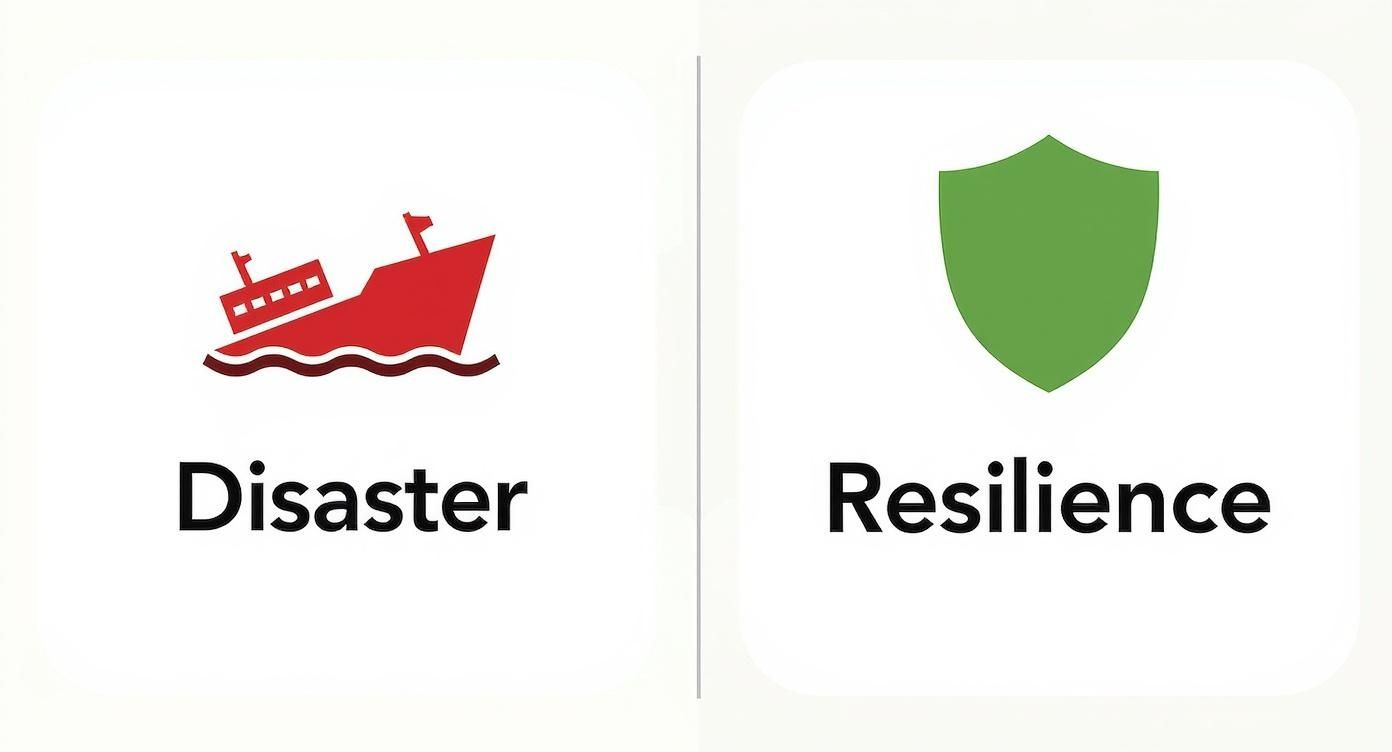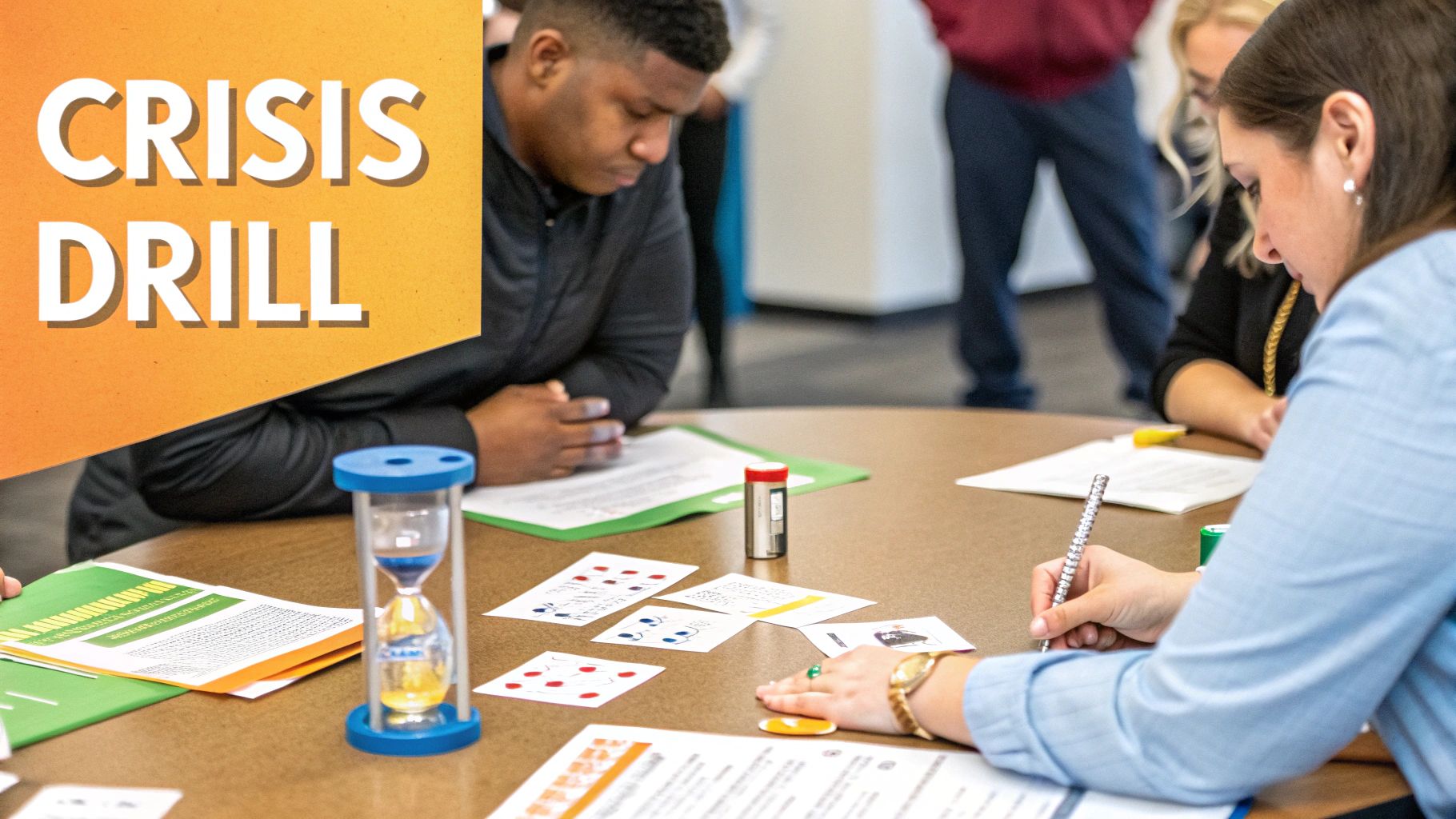When a crisis hits, you're not just managing a problem; you're managing perception. Crisis communication planning is all about getting ahead of the story, controlling the narrative, and protecting the trust you've worked so hard to build.
If you don't have a plan, you're just reacting. And reacting under pressure is a surefire way to make a bad situation a whole lot worse.
Why Winging It Is a Recipe for Disaster
Look, nobody wakes up in the morning expecting a crisis. But when the unexpected happens, the first few hours are pure chaos. Trying to improvise your response in that environment is how you lose control of the situation—fast.
Without a plan, you get delayed responses, conflicting messages from different team members, and a story that gets written by angry customers on Twitter instead of by you. This is how a small, manageable issue spirals into a full-blown reputational meltdown.
Think of a crisis communication plan as an investment in your brand's survival. It shifts your posture from panicked and reactive to calm and in control. A good plan means you've already decided who's on the response team, what your initial messages will be, and who has the final say. This prep work allows you to speak quickly, clearly, and with one voice when it matters most.
The Real Cost of Being Unprepared
Let’s talk about a data breach. Imagine a company gets hit, and they have no plan. They go dark, scrambling to figure out what happened. That silence? It’s deafening. Customers get furious, the media starts speculating, and trust evaporates. By the time the company finally puts out a statement, the narrative is set, and it’s not a good one.
Now, picture a company that was prepared. The moment they confirm the breach, the plan kicks in. They issue a pre-written holding statement that acknowledges the problem, shows they care about their customers, and explains what they're doing right now. This quick, honest communication immediately calms the waters and demonstrates that they are on top of the situation, even in the middle of a storm. The crisis is the same; the response is what makes all the difference.
"When a crisis hits, you won’t have time for a brainstorming session. A plan that only exists on paper is bound to fail. The goal is to build 'muscle memory' in your team, so when a crisis erupts, their response is swift, confident, and almost automatic."
This infographic really drives home the difference between a company that’s ready and one that’s just hoping for the best.

The path is clear: preparation leads to resilience, while improvisation leads straight to disaster. If you want a more detailed look at the kind of frameworks that help you avoid shooting from the hip, this Law Firm Crisis Management Playbook is an excellent resource. It’s all about taking control of the story before it takes control of you.
Putting Your Crisis Response Team Together
Let's be real: a crisis communication plan is just a document until you put the right people in charge of it. When a crisis hits, the last thing you want is a scramble to figure out who’s calling the shots. Building your crisis response team before you need it is arguably the most critical step you can take. It’s the difference between a calm, unified response and total chaos.
This is about more than just naming a spokesperson. It’s about building a well-defined team where everyone knows their job, from the C-suite exec making the final call to the person glued to your social media feeds. A team that’s truly prepared can get moving in minutes, not hours, and speak with one, confident voice.
Who's on the Team? Defining Key Roles
Your crisis team doesn't have to be massive, but every role needs to be crystal clear. I always recommend assigning a primary contact and at least one backup for each position. Crises love to strike when key people are on vacation or completely unreachable.
Here are the non-negotiable roles I see on every effective crisis team:
- Crisis Team Leader: Think of this person as the project manager for the crisis. They aren't always the CEO, but they need the authority to get the team together, guide the conversation, and make sure the plan is actually being followed. They keep everything on track.
- Executive Decision-Maker: This is your final authority, usually the CEO or another top-level leader. They have the power to approve major actions like a product recall or a public apology. They give the ultimate green light.
- Primary Spokesperson: This is the public face and voice of your company. This person has to be media-trained, stay cool under fire, and stick to the script. Interestingly, the CEO isn't always the best choice here. You need someone who can truly master the details of the situation. Our guide on how to become a subject matter expert has some great pointers on developing that kind of authority.
- Legal Counsel: Your legal expert is absolutely essential. They need to put their eyes on every single public statement, from a quick tweet to a formal press release, to make sure you aren't creating a bigger legal mess. Their job is to protect the company without shutting down communication.
- Communications Lead: This is the person (and their team) who does the heavy lifting. They're the ones drafting holding statements, writing social media posts, handling internal memos, and getting press releases out the door. They turn strategy into action.
To make this easier, you can map out your team using a simple chart. This ensures everyone understands their specific function when things get hectic.
Core Crisis Team Roles and Responsibilities
| Role | Primary Responsibility | Key Skills |
|---|---|---|
| Crisis Team Leader | Oversees the entire response, facilitates meetings, and ensures the plan is executed. | Project Management, Leadership, Decisiveness |
| Executive Decision-Maker | Provides final approval on major strategic decisions and resource allocation. | C-Suite Authority, Strategic Thinking |
| Primary Spokesperson | Delivers all official public statements to the media and stakeholders. | Media Training, Public Speaking, Poise |
| Legal Counsel | Reviews all communications for legal risk and ensures regulatory compliance. | Legal Expertise, Risk Assessment, Attention to Detail |
| Communications Lead | Manages the drafting and distribution of all internal and external messages. | Writing, Social Media, Public Relations |
Having this documented ahead of time removes any ambiguity. When the pressure is on, clarity is your best friend.
Key takeaway: Don't just assign these roles on paper—actually empower the people in them. A crisis team that has to wait for four layers of approval to send a tweet is a team that's set up to fail. Speed is everything.
Set Up a Clear Chain of Command
Once you know who is on the team, you need to define how they work together. This isn't about office politics; it's about creating a streamlined flow of information. Everyone needs to know exactly who they report to and who they get their updates from during a crisis.
This simple step prevents the classic "too many cooks" scenario, where different people release conflicting messages because everyone thinks they're in charge. A simple flowchart can work wonders here.
Smart organizations are already ahead of the curve on this. Recent research shows that 68% of companies now have dedicated crisis teams with the power to make quick decisions. And 72% have built the internal systems and external contacts needed to respond fast. You can dig into more of these findings on how top companies are preparing for 2025.
Your 2 a.m. Contact List
So, how do you actually reach everyone at 2 a.m. on a Saturday? An outdated spreadsheet saved on someone’s desktop isn't going to cut it. A core part of your plan is a bulletproof contact system.
This should be a living, cloud-based document that everyone on the team can access instantly. Make sure it includes:
- Primary and secondary phone numbers for all team members.
- Both personal and work email addresses.
- Each person's preferred emergency contact method (some people see texts, others respond to calls).
- Contact info for the designated backups for every role.
And please, test this system! Run a quick drill once a quarter. Send out a test alert to make sure all the info is current and that everyone knows what to do. This is the practical, nitty-gritty work that lets your team leap from just knowing about a crisis to actually managing it.
Developing Messages Before You Need Them

When a crisis explodes, the clock is your enemy. You simply won't have time for a thoughtful brainstorming session or a multi-level review process. The real work happens now, long before you need it, by crafting messages that allow you to respond with speed and confidence when every second matters.
This is about building your communications arsenal. Think of it as creating a library of pre-approved statements that buy you precious time while your team gets a handle on the specific facts of the situation. This prep work is the absolute bedrock of an effective crisis communication plan.
The Lifesaving Role of a Holding Statement
A holding statement is a short, pre-vetted message you can get out the door within the first hour of a crisis. Its job isn't to have all the answers. Instead, it’s designed to show you're aware of what's happening, you're taking it seriously, and you're in control.
These statements are your first line of defense against the rumor mill. They fill the information vacuum that would otherwise be filled by speculation on social media or in the news. Without one, you're letting others—from frustrated customers to opportunistic competitors—define the narrative for you.
A solid holding statement has three simple ingredients:
- Acknowledge: "We are aware of the situation."
- Empathize: "We understand this is concerning for those affected."
- Act: "Our team is actively investigating and we will share more information shortly."
This structure projects competence and compassion, two things you desperately need to maintain public trust when things go sideways.
Crafting Messages That Actually Connect
The tone you strike is just as critical as the facts you share. In a crisis, people are looking for calm leadership and reassurance. Your messages have to walk a fine line to be truly effective.
Aim for communication that is:
- Honest and Transparent: Don't sugarcoat the truth or make promises you can't keep. Trust is built on being upfront, even when the news isn't good.
- Empathetic and Human: Ditch the cold corporate jargon. Acknowledge the human side of the crisis and show you genuinely care. A simple phrase like, "We know this is frustrating," can make a world of difference.
- Confident and Clear: Project a sense of calm and control. Use simple, direct language that anyone can understand, leaving no room for misinterpretation.
"A crisis is no time for ten-dollar words or vague platitudes. Your best tools are clear, empathetic, and direct communication. Get to the point, show you care, and tell people what you're doing about it."
This approach helps you connect with your audience on a personal level, making them far more likely to give you the benefit of the doubt as you work through the problem.
Tailoring Your Message to Who’s Listening
One of the biggest blunders I see companies make is blasting out a single, one-size-fits-all message. What your employees need to hear is entirely different from what your customers, investors, or the media need to know.
A smart crisis plan involves thinking through your different audiences and drafting messages specifically for them. Put yourself in their shoes: what are their biggest concerns? Address those head-on. If you need help with this, our guide on how to identify your target audience (https://redactai.io/blog/how-to-identify-target-audience) offers a great framework you can easily adapt for a crisis scenario.
Here’s a quick look at how you might adjust your focus:
| Audience | Primary Concern | Key Message Focus |
|---|---|---|
| Employees | Job security, personal safety, and what to do. | Give them the facts first. Explain what it means for them and clarify their role in the response. |
| Customers | How they are affected, product/service safety, and how you'll make it right. | Lead with empathy, provide reassurance, and give clear instructions on what they should do next. |
| Investors | Financial fallout, long-term stability, and the leadership's competence. | Project confidence, outline the strategic response, and explain how you're mitigating financial risk. |
| Media | The facts, a timeline, the impact, and an official source. | Provide a single source of truth, be ruthlessly accurate, and direct them to your designated spokesperson. |
By speaking directly to the unique concerns of each group, you demonstrate a deep understanding of the situation from all angles. This targeted approach is infinitely more effective at building and keeping trust. The time you spend on this now will pay for itself a hundred times over when you're in the hot seat.
Managing Your Communication Channels

What you say during a crisis is obviously critical, but where you say it can make or break your entire response. A perfectly crafted message is useless if it never reaches the right people. This is where a smart, multi-channel strategy becomes your best friend, helping you get your story out quickly and clearly.
This isn’t just about blasting the same update everywhere. It’s about being strategic. You have to understand the unique vibe of each channel—from a formal press release to a rapid-fire X post—and tailor your communication to fit the platform and the people on it.
Choosing the Right Channels for the Moment
When things go sideways, you need a mix of owned, earned, and social media channels to steer the conversation. Each one has a specific job to do, and knowing which tool to grab from your toolbox is half the battle.
Here’s a look at your primary options:
- Your Website: This needs to be your "source of truth." Set up a dedicated crisis page or a highly visible banner on your homepage. Every other communication you send out should point people back here for the full, official story.
- Email and Newsletters: This is your direct line to your biggest supporters—your customers, subscribers, and partners. It’s the perfect place for detailed, thoughtful updates that won’t get drowned out by the noise on social media.
- Social Media (X, LinkedIn, etc.): These platforms are all about speed. Use them for real-time updates, to squash misinformation the second it pops up, and to show everyone you're actively engaged. The tone here should feel immediate and conversational.
- Press Releases: This is your formal tool for talking to the media. Save it for major, factual announcements, like when the issue is officially resolved or when your CEO needs to make a definitive statement.
The golden rule? Consistency. The format will change—a tweet is punchy, an email is more personal—but your core message and facts must be identical across the board. Any contradiction, however small, will create confusion and kill credibility.
The Golden Rule: Inform Your Employees First
Before a single press release is drafted or a tweet is scheduled, your own team needs to know what’s happening. This is non-negotiable. Your employees should never, ever find out about a company crisis from a news alert or a trending topic.
When you tell your team first, you accomplish two huge things:
- You build internal trust. Keeping them in the loop shows you respect them and helps calm the inevitable internal anxiety.
- You create an army of ambassadors. A team that understands the situation can help shut down rumors and project a sense of control and stability to the outside world.
Thankfully, technology makes this easier than ever. Companies are leaning on tools like Slack, Microsoft Teams, and other internal messaging platforms to get their crisis teams activated fast. This allows for a much quicker and more coordinated internal response, ensuring your people get the facts first. A comprehensive 2025 report actually dives deep into how tech is shaping modern crisis response.
"Your employees are your first and most important audience. If they don't know what's happening, you've already lost a massive part of the battle for trust. Make them your priority, always."
Adapting Your Message for Each Platform
A one-size-fits-all message just won't cut it. The formal language you use in an investor update will fall completely flat on a fast-moving platform like X. You have to plan for these differences from the start.
Let’s imagine a product recall scenario. Here’s how you’d tailor the message:
- Website: Post a detailed FAQ page with everything customers need: model numbers, step-by-step return instructions, and clear contact info for your support team.
- Email to Customers: Send a personal, empathetic message. Explain the issue, sincerely apologize for the headache it's causing, and link directly to that FAQ page for all the details.
- X (formerly Twitter): Fire off a quick, clear post acknowledging the recall. The goal is speed and direction. Your main job here is to get the word out and point people to your website for more information.
- LinkedIn: Have your CEO or another senior leader post a more formal statement. This message should focus on the company's commitment to safety and quality, reassuring business partners and stakeholders.
This targeted approach isn't just about good PR; it's about being effective. It shows you understand the environment you're operating in, even when you're under immense pressure. This is especially true for social channels, where connecting with clients on Twitter effectively is a skill that pays off big time during a crisis.
Putting Your Crisis Plan to the Test
Let’s be honest. A crisis communication plan sitting in a shared drive, collecting digital dust, is worse than useless—it's a liability. It gives you a false sense of security. Having a plan on paper feels good, but it’s the real-world practice that separates a smooth, professional response from an absolute catastrophe.
This is where you make your plan battle-ready. The goal is to get your team to a place where they don't just know the plan, they live it. When the pressure is on, you don't want people fumbling for a document. You want their response to be swift, confident, and almost automatic. It's all about building that muscle memory before you need it.
Simulating the Pressure with Drills and Exercises
The only way to find the hidden gaps in your strategy is to put it under some real-world pressure. This is where realistic drills and tabletop exercises come in. They’re invaluable for spotting communication bottlenecks, unclear roles, and outdated contact lists before they can cause real damage.
You have a couple of great options here:
- Tabletop Exercises: Think of this as a low-stress, discussion-based walkthrough. You get your crisis team in a room, present them with a realistic scenario—say, a damaging story is about to break, or a critical service goes down—and have them talk through every single step of their response.
- Functional Drills: This is where things get more hands-on. Instead of just talking, your team actually does the work. Maybe they draft a holding statement against a ticking clock, run a mock press conference, or fire up the emergency notification system.
Remember, these exercises aren't about passing or failing. They're about learning. Every single drill will teach you something new, whether it's a weakness in your messaging templates or a flaw in your chain of command.
An untested plan isn't a strategy; it's a hopeful guess. Running drills transforms that guess into a reliable, repeatable process that holds up under pressure.
Identifying and Fixing the Weak Spots
After every single drill, the most important part is the debrief. This is your chance to sit down and be brutally honest about what worked, what didn’t, and why. Don't sugarcoat it. The goal is to make the plan stronger.
As you go through the debrief, zero in on these key questions:
- Response Time: How long did it actually take to get the team assembled and send out that first communication? Was it fast enough?
- Role Clarity: Did everyone know exactly what their job was? Or was there confusion, overlap, and people stepping on each other's toes?
- Message Effectiveness: Were our pre-approved messages actually a good fit for this scenario? Did we have to make major changes on the fly?
- Tool and Channel Access: Did anyone hit a wall trying to access key documents, social media platforms, or contact lists?
The answers you get become your immediate to-do list for refining the plan. This constant cycle of testing, debriefing, and improving is what creates a truly resilient strategy.
Keeping Your Plan Alive and Relevant
Your crisis plan should be a living document, not a "one and done" project you shelve for a year. Team members change, new social media platforms pop up, and the risks facing your business are always evolving. Your plan absolutely has to keep pace.
This isn't just a suggestion; it's what the most prepared organizations do. A global study found that 75% of organizations conduct crisis communication training at least annually, and over 80% exercise their crisis management plans just as often. You can dig into more of these insights in the BCI’s global benchmarking report.
Block out time on the calendar for a full review of your crisis plan at least once a year. On top of that, make sure to update it any time there's a big change, like a new executive joining the team or the company rolling out new internal communication software. An outdated plan can be just as dangerous as having no plan at all.
Learning and Rebuilding After the Storm

Making it through a crisis is one thing. Actually learning from it is something else entirely. The real work starts once the immediate threat is gone and the dust begins to settle. This post-crisis phase is your single best chance to turn a bad situation into a powerful lesson for getting better.
The goal here isn't just to get back to "business as usual." It's about taking a hard, honest look at what happened, rebuilding trust, and using those lessons to make your crisis communication planning rock-solid for the future.
Leading a Productive Post-Crisis Debrief
First things first: get your crisis response team together for a no-blame debrief. Try to do this within a couple of days, while everything is still fresh in everyone’s mind. The focus needs to be on the process, not pointing fingers at people.
You want to create a safe space for honest feedback. Get the conversation flowing with open-ended questions like:
- Speed: How fast were we? Could we have confirmed the facts and gotten our first statement out any quicker?
- Clarity: Did everyone on the team know exactly what their job was? Any confusion about roles?
- Resources: What did we wish we had in those first few critical hours? A specific tool? Better information?
- Messaging: Did our pre-approved messages actually work, or did we have to rewrite them on the fly?
This session is all about finding the weak spots in a calm setting so you can patch them up before the next crisis hits.
A crisis debrief shouldn't feel like an interrogation. Treat it as a collaborative workshop where the goal is collective improvement. Every mistake is a lesson that makes you stronger.
Gathering Feedback and Tracking Your Reputation
Your team’s perspective is crucial, but it’s only half the story. You also need to know how the crisis looked from the outside. Go out and actively ask for feedback from customers, partners, and even employees who weren't directly involved in the response. Their insights can be gold.
At the same time, you need to keep a close eye on the long-term impact on your brand. This means diving into online reputation management. Pay attention to social media sentiment, online reviews, and news mentions for weeks, even months, after the event. Is there still a feeling of distrust, or are people moving on? Our guide on online reputation management tips has some great, practical steps for this.
According to the World Economic Forum, it's common for organizations to see a big drop in public trust after a crisis. This makes being transparent and backing up your words with action absolutely critical for winning back confidence. As one expert puts it, you need to prioritize actions that restore public confidence. Every piece of feedback and data you gather should feed directly back into your crisis plan, turning a painful experience into a more resilient future.
Got Questions? Let's Talk Crisis Comms
https://www.youtube.com/embed/JT5g6z-jDjQ
Even with the best framework in hand, you're bound to have some questions as you dive into the nitty-gritty of crisis planning. It happens to everyone.
Let's walk through a few of the most common questions I hear from teams on the ground.
What’s the Very First Thing I Should Do When a Crisis Hits?
Your first move? Get your team on the same page, fast. Pull together your designated crisis response team immediately to figure out exactly what's happening.
While they're huddling, your communications lead needs to push out a pre-written holding statement. This isn't the time for a detailed explanation. It's a simple, human message that says, "We see this, we're working on it, and we'll be back with more information."
That one simple action buys you precious time and stops rumors from spiraling out of control. In that first hour, speed and acknowledgment are everything.
How Often Should We Dust Off and Update Our Crisis Plan?
Think of your crisis plan as a living document, not something you write once and file away. You should be giving it a thorough review at least once a year.
But don't wait for the annual calendar reminder. You'll also need to revisit the plan anytime your organization goes through a big shift, like:
- New faces in the C-suite.
- Rolling out a game-changing new product.
- Switching to a new internal platform like Slack or Teams.
An outdated plan is a liability. Keeping it fresh ensures you're ready for the challenges of today, not the ones from two years ago.
I see it all the time—the biggest mistake is treating crisis planning like a one-and-done task. It’s a constant process. The world changes, your company changes, and your plan has to change with it.
Does the CEO Have to Be the Spokesperson?
Nope, not always. While having the CEO front-and-center can project authority, the best person for the job is whoever is the most credible and composed on that specific topic.
Sometimes, that’s a lead engineer who can explain a technical failure with clarity, or the head of HR discussing an internal issue. Don’t just default to the biggest title.
Pick the person who can stay on message, connect with the audience, and handle tough questions without breaking a sweat. Media training is non-negotiable for anyone you put in front of a camera.
Ready to build a powerful professional presence before a crisis hits? RedactAI helps you craft authentic, high-impact LinkedIn posts in minutes, so you can build trust and authority with your network every single day. Start creating for free at https://redactai.io.













































































